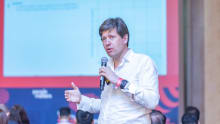Digital is not just about technology: Jason Averbook

TechHR Singapore 2019 Read similar articles

Creating an engaging and enlightening experience for the digital workforce of today is a major challenge faced by several HR leaders. Jason Averbook, CEO and Co-founder, Leapgen, shared some tools and techniques that talent leaders across the globe can implement in their respective organizations, during an in-depth masterclass session at TechHR Conference in Singapore.
Syncing up with the century
There is often a disconnect between the type of technology that employees use in their personal lives vs. the machines that they operate in the workplace.
“You have better apps on your wrist than the company gives you,” noted Averbook. “HR leaders need to change because employees continue to change.”
Organizations do not operate in a vacuum. It is precisely why the dynamic evolution of technology across the globe has put demands on organizational leaders thus reshaping the HR function “forever.”
Technology is NOT equal to digital
Designing a holistic digital workforce experience is not only about technology. A major portion of this experience has nothing to do with technology, according to Averbook.
The formula of 20/25/45/10 of a digital workforce strategy accounts for the four crucial ingredients of building a digital workforce experience: Mindset (20 percent), People (25 percent), Process (45 percent) and Technology (10 percent) are the four pillars essential to building a digital workforce experience.
It begins with the mindset to embrace change and prepare for upcoming transformations in the workplace through a clear vision and strategy. Averbook believes that about 20 percent of a digital workforce lies in the mindset of committing to change.
“When we talk about mindset--we need a digital-first vision,” said Averbook. “When you are starting with digital, we need vision maps.”
Need for a unified digital strategy
The repercussions of not having a cohesive digital strategy and just deploying one technology after another are manifold. Apart from the heavy investment of time and money that goes into implementing a new technology, a lack of understanding of the end goal leads to employee disengagement and inefficiency. The employee experience is “disjointed” and the management and employees both end up blaming the technology.
On the other hand, HR leaders can adopt a step by step approach towards defining the organization’s goals and think beyond technology.
A vision map can help align all the various departments to a particular set of goals. The role of the HR leader lies in providing the workforce with a “customer-like experience.” Treating the employees as your target audience can go a long way in making sure that the digital strategy that the HR department creates is easy to grasp and implement for the employees who would be directly impacted by the transformations in the workings of the company.
Averbook advises HR professionals to keep the following guiding principles while creating a vision map:
- Seamless
- Efficient
- Agile
Driving workforce engagement vs. workforce enragement
After designing the strategy, the next step for HR leaders is to deliver the digital experience to the employees. While implementing the digital framework, it is crucial to understand how employees can be encouraged to experiment and motivated enough to remain engaged.
“You have to bring the capability together with the concept of digital. That’s how we are going to deliver the experiences,” added Averbook.
Workforce engagement happens when the employees adopt new tools as a part of their daily workflow. Employees are more likely to buy-in into the digital experience when they feel empowered to use the technology and when the technology makes their lives more seamless and agile. On the other hand, enragement happens when there is a disconnect between their daily work lives and the use of the new technology.
In order to crack the code of workforce engagement vs. enragement, HR leaders have to understand the employees.
“Our audience is the employee. We might know the employee but do we really understand how they work? Do we really understand how they feel?” said Averbook.
High touch human vs. High touch digital
Many HR leaders tend to forget the value of human interactions amidst all the noise of technology surrounding them. At particular stages of the digital experience, digital touch-points can add value. For example, digital can be a great help in connecting with the candidate in the pre-hiring stage. However, when it is the first day of work for a new employee a one-on-one in-person interaction with the manager is vital to engaging the employee and making them a part of the wider workplace experience.
Averbook summed this up aptly, “There are some processes that require empathy, that machines don’t have,” thus reinforcing the wide scope of HR leaders to build a holistic digital experience for future employees.







